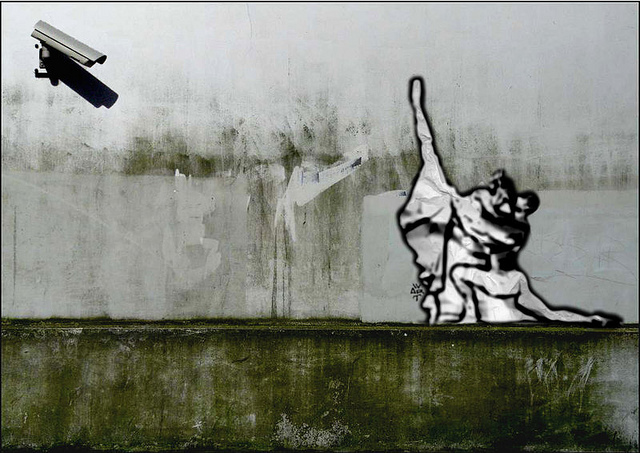
An art exhibit reframes the issue of lack of consent
Imagine yourself at an art exhibit. No, you’re not looking at the art. Or maybe you are looking, as well—but what you’re looking at is a picture of you and your family having dinner, inside your home. And you never intended to have someone take that picture, or to make it public.
A recent exhibit hosted by London Metropolitan University gives unsuspecting internet users the opportunity to find themselves in that position. Nye Thompson, the artist behind the exhibit, brought together images uploaded to the internet from unprotected surveillance cameras. In an article titled “Art Exhibition Sparks Worldwide Privacy Debate,” the university’s website quotes Thompson explaining her motivation: “Millions of the devices around us are already unsafe and betraying our privacy. With the rapid growth of the ‘Internet of Things’, where we will be increasingly surrounded by devices collecting and sharing data on us, this situation is only going to get worse.” Thompson adds, “We need technology companies, regulation bodies, governments and manufacturers to make this issue a priority. Ordinary people shouldn't be expected to be security experts in order to use all these amazing new technologies safely.”
Of course, in this case it is precisely the “ordinary people” (who made the mistake of not password-protecting their camera feeds) who find their privacy violated and have that violation amplified through the exhibit. The ordinary people—not the corporations who made the cameras and didn’t prevent them from functioning unprotected, nor the governments who didn’t mandate such protective measures—are the ones who are put on display.
According to the South China Morning Post, Hong Kong regulators have requested that images of Hong Kong residents be pulled from the exhibit (as the article notes, geolocation data is also involved). In response, a “spokesperson for London Metropolitan University… backed the artist and said the exhibition complied with relevant British privacy laws. The university said it ‘supported artistic freedom of expression, and any work by our alumni which helps to draw public attention to contemporary issues of privacy.’” The organizers of the exhibit did, however, decide to blur the faces of the Hong Kong residents visible in the collected images, although Thompson seemed to feel that this blunted her message in some way, or rendered the artwork less accurate: “The irony here,” she is quoted as saying, “is that even though I am hiding the faces, they are still visible in the search engine results where I found them. The reason they weren’t obscured in the first place was because we didn’t want to give a false idea of what is available online and the extent of our exposure.”
The kinds and amount of personal data available online, about people who didn’t intentionally “share” it, are indeed shocking—and worth highlighting and discussing. But does raising awareness require the showing of identifiable faces, against their possessors’ will? Ironically, the university’s website article about the exhibit is illustrated by a black-and-white photograph of an empty room, with no faces to blur. The image is evocative in its minor details of ordinary life: a wall, and a bit of a chair and desk; an open door leading to what might be a bathroom; what looks like a bathrobe hanging on a clothes hanger. You can imagine people walking through, even though you don’t see them. It feels violative enough already—the idea of the inside of someone’s home, not just posted unwittingly on the public internet, but intentionally selected for an art exhibit, to make a point.
But the exhibit also includes “images of a family having dinner in their living room, children sleeping and a woman sitting on a sofa – all completely oblivious…”
They are not the only ones who come across as oblivious. Privacy violations are harmful—and amplifying them exacerbates the harm. Does privacy education for the many justify the privacy violation of the few? Should artists, too, consider the dictum “First do no harm?”
Photo by kakhunwart, used without modification under a Creative Commons license.
